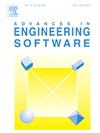A dual-stage combined displacement prediction model for concrete dam based on adaptive time series decomposition noise reduction and residual chaotic feature separation
IF 5.7
2区 工程技术
Q2 COMPUTER SCIENCE, INTERDISCIPLINARY APPLICATIONS
引用次数: 0
Abstract
High-precision analysis and prediction of dam displacement is a crucial strategy to grasp the working attitude of dams and diagnose dam anomalies. However, the existing models often fail to accurately identify the interference noise existing in the form of short-frequency and small-fluctuations, resulting in the masking of the true deformation features. Meanwhile, existing studies often focus on one-stage prediction models, discarding the rich and valuable information contained in the residual sequence. Furthermore, the existing dual-stage models often fail to deeply consider the chaotic characteristics existing in the residuals. Therefore, this paper proposes a dual-stage combined displacement prediction model for concrete dam identifying the displacement sequence interference noise and considering the chaotic characteristics of the residual sequence. Firstly, the adaptive noise complete empirical mode decomposition, the improved sparrow search algorithm and the threshold evaluation index are combined to adaptively achieve the optimal decomposition noise reduction and retain the effective deformation features. Secondly, a gradient boosting tree is utilized to fit the effective component and combine it with the processed noise component to build a high-quality residual sequence that is rich in information. Thirdly, the residual sequence is decomposed into intrinsic mode functions with different temporal characteristics by utilizing the optimized variational mode decomposition. Finally, construct a chaotic time series based on chaos theory. Taking the sample entropy as the basis of judgement, for high-frequency components, the gradient boosting tree algorithm is utilized to capture their dynamic features. For low-frequency components, the depth-separable convolutional neural network, multi-head attention mechanism and bidirectional long short-term memory neural network are organically combined to comprehensively learn the deformation features. Case analysis shows that the RMSE of the model proposed in this paper in the measurement point PL11–5 sequence has reached an astonishing 0.0794, and the maximum improvement degree compared with the control model has reached 79.35 %. The results show that this model obtains strong generalization ability and high robustness, and can provide reference for dam safety monitoring.
基于自适应时间序列分解降噪和残差混沌特征分离的混凝土坝双阶段联合位移预测模型
大坝位移的高精度分析与预测是掌握大坝工作状态、诊断大坝异常的重要手段。然而,现有的模型往往不能准确识别以短波小波动形式存在的干扰噪声,从而掩盖了真实的变形特征。同时,现有的研究往往侧重于单阶段预测模型,而忽略了残差序列中包含的丰富而有价值的信息。此外,现有的双级模型往往没有深入考虑残差中存在的混沌特性。为此,本文提出了一种识别位移序列干扰噪声并考虑残差序列混沌特性的混凝土坝双阶段联合位移预测模型。首先,结合自适应噪声完成经验模态分解、改进的麻雀搜索算法和阈值评价指标,自适应实现最优分解降噪并保留有效变形特征;其次,利用梯度增强树对有效分量进行拟合,并与处理后的噪声分量结合,构建信息丰富的高质量残差序列;第三,利用优化后的变分模态分解方法,将残差序列分解为具有不同时间特征的内禀模态函数。最后,基于混沌理论构造一个混沌时间序列。以样本熵为判断依据,对高频分量采用梯度增强树算法捕获其动态特征。低频分量将深度可分卷积神经网络、多头注意机制和双向长短期记忆神经网络有机结合,全面学习变形特征。实例分析表明,本文提出的模型在测量点PL11-5序列上的RMSE达到了惊人的0.0794,与控制模型相比,最大改善程度达到了79.35%。结果表明,该模型具有较强的泛化能力和较高的鲁棒性,可为大坝安全监测提供参考。
本文章由计算机程序翻译,如有差异,请以英文原文为准。
求助全文
约1分钟内获得全文
求助全文
来源期刊

Advances in Engineering Software
工程技术-计算机:跨学科应用
CiteScore
7.70
自引率
4.20%
发文量
169
审稿时长
37 days
期刊介绍:
The objective of this journal is to communicate recent and projected advances in computer-based engineering techniques. The fields covered include mechanical, aerospace, civil and environmental engineering, with an emphasis on research and development leading to practical problem-solving.
The scope of the journal includes:
• Innovative computational strategies and numerical algorithms for large-scale engineering problems
• Analysis and simulation techniques and systems
• Model and mesh generation
• Control of the accuracy, stability and efficiency of computational process
• Exploitation of new computing environments (eg distributed hetergeneous and collaborative computing)
• Advanced visualization techniques, virtual environments and prototyping
• Applications of AI, knowledge-based systems, computational intelligence, including fuzzy logic, neural networks and evolutionary computations
• Application of object-oriented technology to engineering problems
• Intelligent human computer interfaces
• Design automation, multidisciplinary design and optimization
• CAD, CAE and integrated process and product development systems
• Quality and reliability.
 求助内容:
求助内容: 应助结果提醒方式:
应助结果提醒方式:


